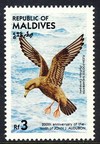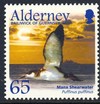Genus Puffinus
Allied - It nowadays contains 5 accepted subspecies, with mtDNA cytochrome b sequence data indicating that the North Atlantic Little Shearwater is closer to Audubon's Shearwater , and myrtae being closer to the Hawaiian and possibly Townsend's Shearwater . Heinroth's Shearwater was also sometimes considered a subspecies of this bird; the relationship between the Little and Audubon's Shearwater is probably not as close as long believed .
Townsend's Shearwater - Townsend's Shearwater, Puffinus auricularis, is a rare seabird of the tropics from the family Procellariidae.
Gray-backed shearwater - Adults birds are 46-47 cm in length, with a 97-99 cm wingspan, and have been recorded to weigh 342-425 g. The upperside of Buller's Shearwater is bluish grey. A blackish stripe runs from the tertiary remiges to the primary wing coverts. The primary remiges are blackish also; the two black areas do not meet at the hand however; the area between them is a rather light gray, under bright light it may appear almost white. With the bird facing upwards, the pattern gives the impression of a broken black "M", with light gray interspersing areas.
Pale-footed Shearwater - It breeds in colonies, and has two main breeding areas: one in the South West Pacific Ocean includes Lord Howe Island and northern New Zealand ; the other is along the coast of Western Australia from Cape Leeuwin to the Recherche Archipelago. Another 600 pairs breed on St Paul Island in the Indian Ocean, as well in the Astola Island of Pakistan in the Arabian Sea. It occurs as a summer visitor in the North Pacific Ocean as far north as British Columbia. Flesh-footed shearwaters have been sighted in the Central-North Pacific, above the main Hawaiian Islands as well.
Pink-footed Shearwater - This species is pelagic, occurring in the Pacific Ocean. It predominantly nests on offshore islands off Chile, ie.
Fluttering Shearwater - The Fluttering Shearwater is a species of seabird in the Procellariidae family. It is found in New Zealand and Solomon Islands. Its natural habitats are open seas and rocky shores.
Great Shearwater - The Great Shearwater is a large shearwater in the seabird family Procellariidae. Its relationships are unclear. It belongs in the group of large species that could be separated as genus Ardenna ; within these, it might be allied with the other black-billed, blunt-tailed species Short-tailed Shearwater and especially Sooty Shearwater . Alternatively , it could be a monotypic subgenus , an Atlantic representative of the light-billed Hemipuffinus group .
Sooty shearwater - It appears to be particularly closely related to the Great and Short-tailed Shearwaters, all blunt-tailed, black-billed species, but its precise relationships are obscure
Heinroth's Shearwater - Heinroth's Shearwater is a poorly known seabird in the family Procellariidae. Probably a close relative of the Little Shearwater or Audubon's Shearwater , it is distinguished by a long and slender bill and a brown-washed underside.
Hutton's Shearwater - It is an endemic breeder of New Zealand, with breeding restricted to only two remaining colonies in the Kaikoura Seaward Ranges, Kaikoura. During the non-breeding winter months migration occurs to South Australia. Some anecdotal evidence suggests pre-breeding birds circumnavigate Australia in the years leading up to sexual maturity.
Dusky shearwater - Puffinus assimilis lherminieri Lesson, 1839 Puffinus atrodorsalis Shirihai, Sinclair and Colston, 1995 Puffinus bailloni Puffinus bannermani Mathews & Iredale, 1915 Puffinus baroli Puffinus persicus Hume, 1872 Pufflnus lherminieri Lesson, 1839 and see text
Balearic Shearwater - The Balearic Shearwater is a medium-sized shearwater in the seabird family Procellariidae. It was long regarded a subspecies of the Manx Shearwater; see there for more on the Puffinus puffinus superspecies; following an initial split it was held to be a subspecies of the "Mediterranean Shearwater" for nearly ten more years, until it was resolved to be a distinct species, separate from the Yelkouan Shearwater . It is the last taxon of the puffinus complex that was recognized as a separate entity.
Christmas Shearwater - It is one member of a very ancient lineage of the small Puffinus species. Its only close living relative is the Galápagos Shearwater , as indicated by mtDNA cytochrome b sequence data and morphology. Until recently, that species was considered conspecific with Audubon's Shearwater.
Puffinus newelli - Newell's Shearwater or Hawaiian Shearwater is a seabird belonging to the genus Puffinus in the family Procellariidae. It belongs to a confusing group of shearwaters which are difficult to identify and whose classification is controversial. It was formerly treated as a subspecies of the Manx Shearwater and is now often placed in Townsend's Shearwater . It is endemic to the Hawaiian Islands as a breeding bird. Its population is declining and it is classed as an endangered species by BirdLife International. It is known in Hawaiian as the ʻaʻo.
Black-vented Shearwater - This species is pelagic, occurring in the Pacific Ocean and the Gulf of California. It comes closer to land than most other shearwaters, so it sometimes can be seen from shore. It predominantly nests on offshore islands off north and western Baja California, namely Isla de Guadalupe, Islas San Benito and Isla Natividad. It is fairly common off the United States coast of central and southern California during the country's colder months.
Wedge-tailed Shearwater - The Wedge-tailed Shearwater, Puffinus pacificus is a medium-large shearwater in the seabird family Procellariidae. It is one of the shearwater species that is sometimes referred to as a Muttonbird, like the Sooty Shearwater of New Zealand and the Short-tailed Shearwater of Australia. It ranges across from throughout the tropical Pacific and Indian Ocean roughly between latitudes 35°N and 35°S. It breeds in islands such as off Japan, the Islas Revillagigedo, the Hawaiian Islands, the Seychelles and off Western Australia.
Manx shearwater - The Manx Shearwater is a medium-sized shearwater in the seabird family Procellariidae. The scientific name of this species records a name shift: Manx Shearwaters were called Manks Puffins in the 17th Century. Puffin is an Anglo-Norman word for the cured carcasses of nestling shearwaters. The Atlantic Puffin acquired the name much later, possibly because of its similar nesting habits.
Slender-billed shearwater - This species appears to be related to the New Zealand muttonbird and the Great Shearwater, all blunt-tailed, black-billed species, but its precise relationships are obscure . These are among the larger species of shearwater which might belong into a separate genus, Ardenna .
Yelkouan Shearwater - The Yelkouan Shearwater, Levantine Shearwater or Mediterranean Shearwater is a medium-sized shearwater in the seabird family Procellariidae.








